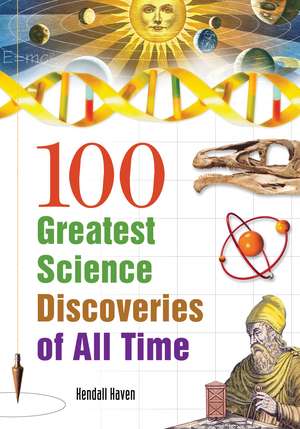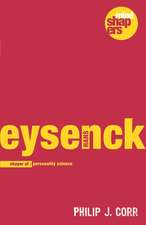100 Greatest Science Discoveries of All Time
Autor Kendall Havenen Limba Engleză Paperback – 27 feb 2007 – vârsta până la 17 ani
Preț: 241.95 lei
Preț vechi: 291.48 lei
-17% Nou
Puncte Express: 363
Preț estimativ în valută:
46.30€ • 48.47$ • 38.31£
46.30€ • 48.47$ • 38.31£
Carte tipărită la comandă
Livrare economică 05-19 aprilie
Preluare comenzi: 021 569.72.76
Specificații
ISBN-13: 9781591582656
ISBN-10: 1591582652
Pagini: 272
Dimensiuni: 178 x 254 x 17 mm
Greutate: 0.57 kg
Editura: Bloomsbury Publishing
Colecția Libraries Unlimited
Locul publicării:New York, United States
ISBN-10: 1591582652
Pagini: 272
Dimensiuni: 178 x 254 x 17 mm
Greutate: 0.57 kg
Editura: Bloomsbury Publishing
Colecția Libraries Unlimited
Locul publicării:New York, United States
Notă biografică
Kendall Haven is a nationally recognized master storyteller and the author of numerous books, including Marvels of Math, Write Right!, and Close Encounters with Deadly Dangers. A former research scientist, he is based in Fulton, California.
Recenzii
A former research scientist, Haven is now a nationally-recognized master storyteller and author of numerous books. His latest offering for students and interested general readers briefly describes the 100 scientific discoveries which have had the greatest impact on the development of human science and thinking, from Archimedes' discovery of the two fundamental principles underlying physics and engineering to recent work on the human genome. The text provides not only information on science discoveries, but also on the process of doing science and insights into the lives key people in the field. Each entry includes a definition of the discovery and its name, the year of discovery, discovering scientist, why it ranks as one of the 100 greatest, how it was discovered, and a reference list.
Listed in chronological order, the discoveries range from young Archimedes's description of levers (ca. 260 B.C.E.) and Vesalius's revolutionary study of human anatomy (1543) to Neils Bohr's theory of atomic bonding (1913) and the mapping of the human genome (2003). The author opens each entry with a lucid justification for its inclusion, goes on to relate each discovery's circumstances in a lively way (Tipped off that Franklin had new information, Crick stole one of the Rosalind's X-shaped X-rays), and concludes with a substantial reading list..[w]ould make a useful supplemental resource for students of the history of science.
While this reference is indicated for students grades 6 and up, it's reviewed here for its importance and relevance to many a high school to adult reader who wants a chronological chart of the most notable scientific discoveries, from Archimedes' discovery of the two basic principles underlying physics to discoveries about human anatomy and black holes. From health to astronomy, fun facts about these scientific breakthroughs gather the real stories behind discoveries and reveal how scientists work to prove or disprove theories.
Each discovery is described in two pages and has the year of discovery, an inset box with What is it? and Who discovered it? A paragraph defends Why is this one of the 100 greatest? and continues with How it was discovered. Fun Facts are shown with a light bulb icon, and a More to explore bibliography will have six or more citations for further research. In settling students at the beginning of each class, science teachers may choose to read one of these entries either one day or stretch it over two days. While it belongs on the reference shelf, you may want to have one or more copies for your circulating collection. This is a winner and you will want to book talk it for your science teachers as soon as your copy arrives. Helping them integrate this content into their curriculum will help make science more important to students who might be less interested.
Listed in chronological order, the discoveries range from young Archimedes's description of levers (ca. 260 B.C.E.) and Vesalius's revolutionary study of human anatomy (1543) to Neils Bohr's theory of atomic bonding (1913) and the mapping of the human genome (2003). The author opens each entry with a lucid justification for its inclusion, goes on to relate each discovery's circumstances in a lively way (Tipped off that Franklin had new information, Crick stole one of the Rosalind's X-shaped X-rays), and concludes with a substantial reading list..[w]ould make a useful supplemental resource for students of the history of science.
While this reference is indicated for students grades 6 and up, it's reviewed here for its importance and relevance to many a high school to adult reader who wants a chronological chart of the most notable scientific discoveries, from Archimedes' discovery of the two basic principles underlying physics to discoveries about human anatomy and black holes. From health to astronomy, fun facts about these scientific breakthroughs gather the real stories behind discoveries and reveal how scientists work to prove or disprove theories.
Each discovery is described in two pages and has the year of discovery, an inset box with What is it? and Who discovered it? A paragraph defends Why is this one of the 100 greatest? and continues with How it was discovered. Fun Facts are shown with a light bulb icon, and a More to explore bibliography will have six or more citations for further research. In settling students at the beginning of each class, science teachers may choose to read one of these entries either one day or stretch it over two days. While it belongs on the reference shelf, you may want to have one or more copies for your circulating collection. This is a winner and you will want to book talk it for your science teachers as soon as your copy arrives. Helping them integrate this content into their curriculum will help make science more important to students who might be less interested.















